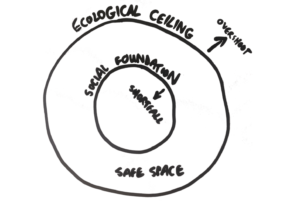We’re not going back to normal.
Origin: Future Crunch – Portal Economics Part 1 & Part 2
When this is all over, we’ll take longer walks, watch our parents read to their grandchildren, laugh at our friends, and never take hugs for granted again.
The uncomfortable truth though, is that as this first wave of lockdowns ease and we try to return to our normal lives, this isn’t going to be over.
Early reports suggested it was a standard variety respiratory disease. We’ve since learned that it attacks not only the lungs, but most of the body’s vital organs.
The implication is that we’re not just looking at a single lockdown, but at a succession of them—not just one mother-of-all-economic-shocks but overlapping waves of shocks that threaten the foundations of the global economy. If that sounds like an exaggeration, consider that the ILO is now predicting the loss of 195 million jobs (compared to 22 million in 2008-2009) and the IMF says the collapse in global output is likely to exceed that of any recession in the last 150 years – that is, in the entire history of capitalism.
We’re not going back to normal.
…this is not a natural disaster, like an earthquake, a one-off event from which we can rebuild. It’s not an invasion or a war, or a financial crisis either. There are deaths, but no combatants, no physical resources have been destroyed, and there was no initial market crash, although obviously the markets are now reacting.
The crisis is of the entire system we’ve built…
…The crisis is being spun into a partisan Rorschach test in front of our eyes. The conservatives favour a swift economic restart and bemoan the comeback of the state. The progressives urge more intervention, and insist on longer lockdowns. Everyone ignores the socialists, who circulate manifestos and anxiously thumb their revolutionary rosaries. The realists fret about the rise of nationalism and the ascendance of China, while the pluralists scratch their heads over the failure of global governance, and the retreat of globalisation.
Lost amidst the ideological squabbling are those hit hardest by the pandemic, the migrants, day labourers, refugees, the urban poor, the undocumented, the homeless and the marginalised. As the rich loot the coffers (the cost of tax breaks for the wealthiest one percent in the US government’s $2 trillion stimulus was greater than the amount funded for all hospitals in America) and the chattering classes (yep, that’s us) learn how to bake sourdough, millions are left without protection from both the virus and the lockdown measures, stranded as support networks collapse, and already precarious sources of income disappear.
In 1981, in his inaugural address, Ronald Reagan declared “Government is not the solution to our problem; government is the problem.” In the forty years since, this view has come to dominate economic policymaking in the West. The market, if left alone, will drive innovation and allocate resources in the most efficient way, creating a bigger pie and leaving everyone better off. The state’s role is to uphold property rights, perhaps do a bit of regulatory ‘nudging’ here and there and take care of ‘externalities’ like, uh, climate change.

Over the course of a few, crazy months in 2008, the accepted wisdom was turned on its head. We learned that at the heart of our profit-driven, private financial economy is a state-managed entity, the central bank. When markets function normally, it remains in the background. As soon as they break down though, it becomes the ‘lender of last resort.’…
Once the crisis passed however, memories faded. Even though the ‘states bad, markets good’ story had been exposed as a sham, for a generation of policymakers trained at the same universities, the old habits died hard.
Almost every political fight, including the culture wars, can be traced back to this binary. States versus markets. Equality versus efficiency. Redistribution versus growth.
…As of the 10th of April, governments across the globe had announced $10.6 trillion in stimulus measures, the equivalent of eight Marshall Plans. “POW!#*@ BAM&$# SMASH! @#$% KABOOM* #!@?% That’s the sound of the Fed’s big bazooka” goes one typical report. Once again, we’ve been treated to a crash course in how much power the state does have –how much it can accomplish when it realises it must act boldly or risk being seen as fundamentally illegitimate. … Pankaj Mishra sums it up nicely: “It has taken a disaster for the state to assume its original responsibility to protect citizens.”
One person who has been wrestling with that prospect is Mariana Mazzucato. While many of her colleagues have spent the last decade scolding capitalism, she’s been re-imagining its basic premises. Where does growth come from? What is the source of innovation? How can the state and private sector work together to create the dynamic economies we want?
Mazzucato decided to delve deeper into the history of the world’s most innovative companies, and discovered that the long-accepted binary of an agile private sector and a lumbering, inefficient state was a myth. Her research revealed that government agencies have played a critical role in the development of most of the general purpose technologies that now drive economic growth, such as the internet, the smartphone, clean energy, and pharmaceutical drugs. All of these were funded in their early stages by public dollars.
“History tells us that innovation is an outcome of a massive collective effort – not just from a narrow group of young white men in California. If we want to solve the world’s biggest problems, we better understand that.”
Echoing Amartya Sen, Mazzucato believes that in order for societies to succeed they need both the invisible hand of free markets and the visible hand of good governance.

For as long as we can remember, we’ve been told that all the exciting bits of the economy belong to the private sector, but she turns that idea on its head, showing us that the state has been there all along, an unloved and underappreciated driver of innovation and co-creator of wealth.
Private companies have been able to suck value out of the economy for decades, piggybacking off basic government research and then using the profits to buy back their stocks, inflating the value and rewarding CEOs and shareholders. Again and again, we see this story playing out in industries like airlines, banking, pharmaceuticals, tech, property and agriculture.
This time around, she says, when big business comes begging for help, the state should wise up, and socialise both the risks and the rewards, embracing its ‘entrepreneurial spirit.’ If the public sector is crucial to major technological developments then taxpayers should get a larger share, through royalties or equity, or by including conditions that steer businesses towards value creation instead of value extraction. More research and worker training – less share buybacks and golfing.
Of course, when public investments go wrong, there’s the danger of public uproar. Mazzucato suggests that to counter this, the rewards should be more explicit. … progressives are losing around the world because they focus too much on redistribution and not enough on the creation of wealth.
“If we continue to depict the state as only a facilitator and administrator, and tell it to stop dreaming,” she writes, “in the end that is what we get.”
Her most influential piece of work however, was the design of the European Union’s new, €100 billion research and innovation agenda, centred around five mission areas: adaptation to climate change; cancer; healthy oceans and waterways; climate-neutral and smart cities; and soil health and food.
What Mariana Mazzucato is offering us here is something both broad and scarce: a compelling new story about how the left and right can work together to get us to a better future. It tears down the artificial binary between saving lives and saving livelihoods, putting the two circles of the state and markets onto a spectrum, and showing us that they both are intimately involved in delivering both of these goals. It’s a huge step in the right direction, a way to do capitalism differently.
PART 2
There will be other pandemics in the future though, potentially worse than this one, and looming large on the sidelines, climate change. Going back to normal guarantees more trouble down the line. Framed this way, COVID-19 isn’t a disease, it’s a symptom. As systems thinker Gregory Bateson has written, “That is the paradigm: Treat the symptom to make the world safe for the pathology.”
The true disease, the ‘pathology’ he’s talking about here, is an economy that’s built for perpetual growth. For the past century, this has brought untold benefits to humanity —if you’ve been following Future Crunch for any length of time you’ll know we think that’s something worth celebrating. Thanks to the miracle of growth and the extraordinary inventiveness of capitalism, our species has lifted billions out of poverty, dramatically improved global health, expanded literacy and education, and given three quarters of adults on earth access to the greatest information resource in human history.
The miracle cannot continue forever. Global economic development has also fuelled a dramatic increase in our use of Earth’s resources, first driven by the resource-intensive lifestyles of today’s rich countries, and more recently redoubled by the rapid growth of the global middle class.
At some point, we’re going to hit a wall. If we get a ‘V-shaped recovery’ and manage to return to our former average annual growth rate of 3%, the global economy will be three times bigger by 2050 than it is today. Let that sink in for a minute. Even if we can do what Mazzacuto suggests, and get states and markets working together to, say, clean up our entire energy system and provide healthcare for all (and that’s the biggest ‘if’ of all time), we’re still going to be making and consuming an unimaginable amount of stuff. … Our two century long experiment with industrialism is self-terminating. Either we figure out a way to end it ourselves, or it does the job for us.
How, for example, are we supposed to build all those roads and hospitals, or manufacture all those wind turbines and solar panels, if we’ve got an economy that’s going in reverse? Not to mention, it’s all very well for those of us sitting at the top of the pile to say ‘stop’ but what about the bottom billion, still waiting for their chance to climb the socioeconomic ladder? In the last three decades China has grown its GDP per capita by a factor of eight, and in the process pulled off the single biggest transfer of wealth to the global poor in human history. It’s unfair to insist other nations shouldn’t follow suit.
No country has ever ended human deprivation without a growing economy. And no country has ever ended ecological degradation with one.
Kate Raworth started asking questions in the wake of the last financial crisis. She went a step further though, and decided to tackle the most sacred cow in all of economics —the assumption that economies should always grow.
…Today, we think about economics as a technical subject, a game of graphs and numbers. The first economists however, were more like moral philosophers, trying to articulate what a society’s goals should be, and what the best way of getting there was. In the early 20th century, that changed. „ Discussion of the economy’s goals disappeared from view, creating a moral vacuum at its heart.
Into that space stepped a measurement —gross domestic product, created in the 1930s as a way for policymakers in the United States to track the country’s recovery from the Great Depression. …Today, if you pick up any popular economics book, or follow any famous economist on Twitter, you’ll see that they talk about efficiency, productivity and growth as if these values were self-explanatory.
They’re not. … as Robert Kennedy said more than fifty years ago, that line measures “neither our wit nor our courage, neither our wisdom nor our learning, neither our compassion nor our devotion to our country, it measures everything in short, except that which makes life worthwhile.”
We can now add another criticism to his list. If we continue using GDP growth as our metric for success, then we’re going to destroy the conditions that gave rise to human civilisation itself. We need new metrics, and we need a new mindset. “What we have are economies that need to grow, whether or not they make us thrive,” says Raworth. “What we need, especially in the richest countries, are economies that make us thrive, whether or not they grow.”
Welcome to her genius idea — doughnut economics.

In this diagram, humanity’s resource use radiates out from the centre. The inner ring, the social foundation, represents the minimum that we need to live a thriving life. Below it, falling into the hole, are all the people who don’t have access to basic needs such as food, water, healthcare, education, political voice and housing, things that everyone needs for a life of dignity and opportunity. As a society, our primary goal should be to get everyone over that boundary.
However, in doing so, we can’t let our resource use overshoot our ecological limits, represented by the outer ring. Beyond that lies critical planetary overshoot in the form of ocean acidification, chemical pollution, air pollution, biodiversity loss, topsoil loss, and climate change. As biomimicry thinker Janine Benyus, one of Raworth’s collaborators puts it, ‘when a bird builds a nest in a tree, it takes care not to destroy the surrounding forest in the process’. In the middle lies a sweet spot —shaped unmistakably like a doughnut— that is both an ecologically safe and socially just space for humanity.
Change of course, doesn’t happen overnight. It’s a hard slog. It doesn’t matter how good your idea is, you have to repeat it over and over again until the small ripples turn into larger ones. The doughnut has made an appearance at the headquarters of the OECD, World Bank and the UNDP, at the World Economic Forum, and in 2015 during late night negotiations on the UN Sustainable Development Goals, insiders reported that a large version sat on the table as a reminder. However, it’s always been an idea — until a few weeks ago, when Amsterdam announced that its post-pandemic recovery strategy will be based on “the world’s first City Doughnut” economic model.
The ripples of Raworth’s ideas are spreading, and as this crisis deepens, we may find that their time has finally come. Those two concentric rings, after all, don’t just look like a doughnut. They look like a portal, too.
“When this is all over”
The next time you catch yourself saying it, remember:
- It’s not a mantra.
- It’s not a policy.
- It’s an invitation.
If this pandemic doesn’t invite us to rethink what kind of world we want to live in then we’re not sure what will.
…we’ve introduced you to Mariana Mazzacuto and Kate Raworth… Are their prescriptions unrealistic? Perhaps. Optimistic? Definitely. But remember, over the long term, the future is always decided by optimists. To be an optimist you don’t have to ignore the many problems we create; you just have to imagine improving our capacity to solve them.
So imagine an economy on the other side of the portal, one hammered out … on adaptability.… Growth can happen …but there are boundaries that make it clear what the right thing to build is, allowing us to differentiate among sectors that should grow and need investment (clean energy, public transport, education, health)
and sectors that need to radically de-grow (oil, gas, coal, advertising, finance).
On the other side of the portal, we’ve still got access to the dynamism of the market, with its unparalleled ability to create, innovate and allocate efficiently. However, it’s backed by an innovative state, one that’s willing to fund basic research and take risks on brand new technologies the marketplace hasn’t even dreamed of. The state is also there to protect citizens from the market’s inevitable swings, crashes and wealth-concentrating effects, providing healthcare, liveable wages, housing, basic income, political voice, and freedom from discrimination.
Linear supply chains are replaced by circular ones, agriculture is transformed from an extractive to a regenerative activity, and ecosystems are protected and treasured for what they truly are —the source of all life—
We need to try something new. Don’t wait until it’s all over.
